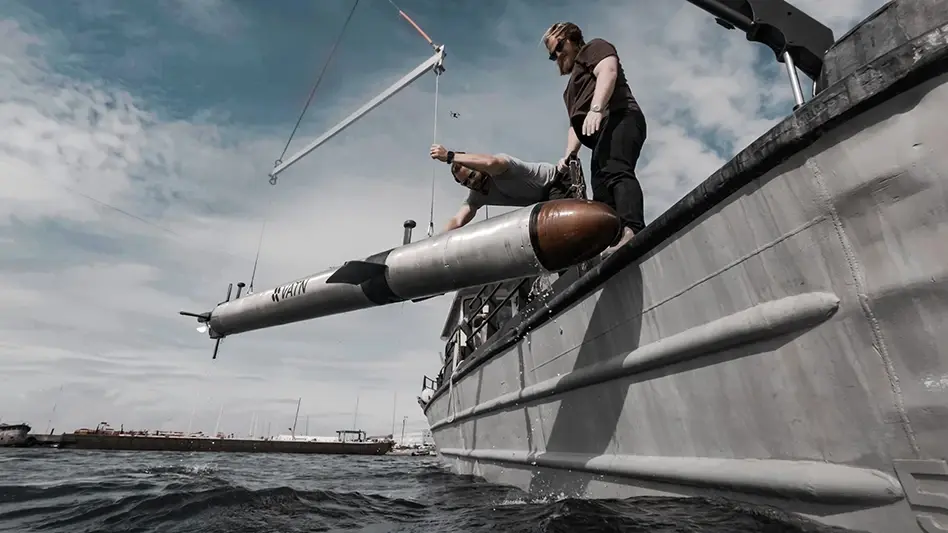In case you didn’t know, it’s like really, really hard to navigate at sea. And that gets even harder when you’re putting drones under the water—like autonomous underwater vehicle (AUV) company Vatn Systems is.
Well, yesterday, the Rhode Island-based startup announced that they’ve found a solution: They have developed their very own inertial navigation system (INS) called INStinct that guides drones more precisely and at a “fraction of the cost” of traditional solutions.
“We realized pretty quickly that the biggest barrier to building affordable underwater vehicles is navigation,” Vatn CEO Nelson Mills told Tectonic. “Everyone uses these off-the-shelf, very expensive—like $100K plus—nav systems. Those ultimately cost more than our vehicles. We needed a solution that enabled our users to get acceptable accuracy and precision for the missions they want to run.”
The system was developed using IMU (Inertial Measurement Unit) tech built by ANELLO Photonics. Partnerships for the win.
Dive deep: Before we jump into the maritime tech, a bit about Vatn: The company was founded in 2023 by a team of maritime and military experts, led by Nelson and his brother Freddie, now COO. The company:
- Raised a $13M seed round from investors including DYNE Ventures, RTX Ventures, Lockheed Martin Ventures, and In-Q-Tel last year.
- Has two torpedo-like drones for defense purposes: the Skelmir S6 and the Skelmir S12.
- Produces drones for both commercial and defense purposes. The AUVs can be used for port security or search and rescue, as well as for carrying explosive payloads.
- Builds out of a new, souped-up manufacturing facility (powered by Palantir) in Bristol, Rhode Island.
Vatn’s tech was built with an eye on future maritime-heavy conflicts—like a potential one with China in the Indo-Pacific. The idea is to deploy swarms of cheap, attritable AUVs that can swarm en masse. But to do that, you need solid navigation—that’s where the new INS system comes in.
ET phone home: Now, it’s been a while since we’ve broken down a highly technical concept for y’all, so strap in. What in the heck is INS, and why did Vatn build their own?
Basically, when you put something—like Vatn’s torpedo-like AUVs—under the water, you lose the ability to navigate using GPS/GNSS. Think of it as a totally jammed environment.
Navigation, instead, relies on inertial and acoustic tech—including inertial navigation systems. Basically, these INS systems use accelerometers and gyroscopes to determine the position of an object (like a UUV or even a submarine) by measuring acceleration and rotation.
- A set of accelerometers measure linear acceleration, while the gyroscopes measure rotation rate.
- The system starts out from a known GPS/GNSS location (before the object is submerged), then uses these to figure out position from there.
- INS systems can be combo’d with acoustic systems (think sonar) to make them more accurate.
The problem is, these systems aren’t always super on-point (they’re basically guesstimating position) and the traditional ones are really, really expensive. Mills told Tectonic that Vatn’s fixed both of those problems—two birds, one stone.
- Basically, Vatn’s system takes the IMU data from ANELLO’s kit and combines it with a set of proprietary algorithms that help determine location.
- They can combine that data with things like Doppler velocity log data, which improves positioning, Mills said.
- Over time, because the system is modular, Mills said that they could add things like magnetometers and sonar-based mapping that could improve positioning even further.
- Off-the-shelf solutions are like a black box, Mills said. This INS system can be upgraded by Vatn and their partners to meet specific mission needs.
- In the future, it could enable things like collaborative navigation, where one vehicle with advanced INS could lead a whole swarm.
Mills said that in tests on short ranges—like one to two kilometers—they’ve been within GPS accuracy, all at about 3-4X cheaper than standard systems.
Sold for parts: The company started work on INStinct about a year ago, he said, though they’d been talking about it long before that.
Vatn already has about eight Skelmirs with the new INS system built in, ready to ship out to partners. Plus, every single one of their underwater drones will have the new navigation system built in from here on out. They plan to start selling INStinct as a standalone system to other companies next year.
Everyone is getting on the supplier train, it would seem.

